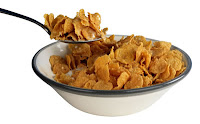Apparently I’m not getting my Recommended Daily Intake (RDI) of sugar. According to the box of Kellogg’s Corn Flakes I encountered in the supermarket this morning, I am supposed to be eating 90g of the stuff every day (or almost 33kg a year).
Hang on! I should be eating almost 22 teaspoons of sugar every day?! Where do they get that from? I had to find out more.
You won’t find it on their packs, but the answer is buried on the Kellogg’s site under the FAQ for Health Professionals. They say:
Sugar – 90g – Based on 18% of total energy. This is in line with the Dietary Guidelines for Australian Adults [2003] which recommend to consume only moderate amounts of sugars and foods containing added sugars, and is consistent with the target stated by the Nutrition Taskforce of the Better Health Commission [1987]
I added the links into that quote to make it a bit easier for you to check than Kellogg’s did. The first report does not set a target of 90g per day or indeed any target at all. It just says you should moderate your intake of sugars.
The second report is so old that it isn’t available on the internet so I can’t tell you what it says. But given the first report was written 16 years later and doesn’t mention any guidelines from that older report, I don’t hold out much hope for finding the 90g figure in it either. And even if it did contain such a recommendation, I wouldn’t put much trust in it given the mountain of human metabolism research that’s been done since then.
Perhaps Kellogg’s pulled the 90g from The Daily Intake Guide produced by its industry lobby group, the Australian Food and Grocery Council. That guide also uses the 90g figure. It says that the value is ‘derived from the Nutrient Reference Values for Australia and New Zealand’ [2006].
That document prepared by Department of Health and Ageing and does not set any RDI for sugar at all. It simply notes that the World Health Organisation recommended a level of not more than 10% of energy from sugar in its 2003 Report on Diet and Chronic Diseases.
So in short, I’m at a loss as to where Kellogg’s (and everyone else who signed on to the AFGCs nutrition labelling system) got the figure of 90g of sugar from. But I do know that putting that on a packet of cereal makes it seem ok that a standard serve (by that I mean what your kids actually eat not what the pack calls a standard serve) contains up to five teaspoons of sugar. After all, that’s less than a quarter of your RDI.
Calling it an RDI gives legitimacy to the figure as if it’s an essential nutrient without which we would expire. No-one needs to eat 3kg of sugar a year, let alone 33kg!
It’s time for food manufacturers to stop playing ducks and drakes with food labelling. The RDI for sugar should be 0g per day and the amount the food exceeds that should be clearly labelled.

















to put it simpley 10grams of sugar per 100grams is alot of sugar 2grams is a little. men should not have more than 34grams of sugar per day women no more than 28grams.
how did you get the paypal link in your blog! i want to do that. thanks, i’m just starting out writing & am trying to learn all the tricks. is it easy to be followed on twitter, you seem to be very popular! best, debbie